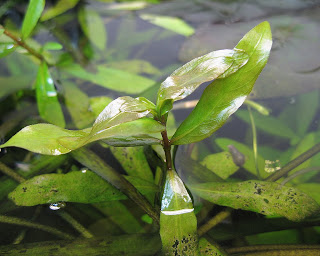Algae in Freshwater Aquarium
Facing the problem of algae in aquarium is commonplace and became one of the main routines that must be considered for freshwater aquarium enthusiasts. Things that should to know, algae are a perfectly normal part of nature, flora and even the freshwater aquarium.
 Their incidence is very common, because the spores of algae is transferred only to plants, but their spores are even carries the air. Can be ascertained, algae are always present in every aquarium, but it depends on their quantity.
Their incidence is very common, because the spores of algae is transferred only to plants, but their spores are even carries the air. Can be ascertained, algae are always present in every aquarium, but it depends on their quantity.
Interestingly, for some people see the aquarium without plants which strongly overgrown with algae is look very natural and nice. The problem occurs when we have a nice aquarium plants and algae is ugly scar, but also in some cases completely choked the plants. Nice aquarium plant and algae can not be paired together. I hope that those who decided to algae in their aquarium turn, this article will help in heavy fighting.
Appearance: Creating clusters decorating the edges and aquarium plants. Overgrowth creates a powerful thick carpets.
Specifics:
Appearance: the most frequently occur as filamentous algae or sessile horizontally.
Specifics:
Appearance: brown, dry to the touch like a gritty coating on the walls of the aquarium, equipment and plants. Looks a bit like water established in the brown stone design.
Appearance: glaucoma, or a thick greasy coating on the plants and aquarium equipment, which smells a bit.
Specifics:
Beware to the most common causes of aquarium algae problem below:
How to get rid of them?
If the aquarium algae overgrove to unacceptable levels, the incidence can be significantly reduced if they cease to create suitable conditions for life, unless, remove the causes of their occurrence. The basic steps you can do...
Read more »
 Their incidence is very common, because the spores of algae is transferred only to plants, but their spores are even carries the air. Can be ascertained, algae are always present in every aquarium, but it depends on their quantity.
Their incidence is very common, because the spores of algae is transferred only to plants, but their spores are even carries the air. Can be ascertained, algae are always present in every aquarium, but it depends on their quantity.Interestingly, for some people see the aquarium without plants which strongly overgrown with algae is look very natural and nice. The problem occurs when we have a nice aquarium plants and algae is ugly scar, but also in some cases completely choked the plants. Nice aquarium plant and algae can not be paired together. I hope that those who decided to algae in their aquarium turn, this article will help in heavy fighting.
Basic types of algae commonly occurring in aquarium:
1. Red algae - Brush algaeAppearance: Creating clusters decorating the edges and aquarium plants. Overgrowth creates a powerful thick carpets.
Specifics:
- very difficult to remove mechanically,
- fish and snails do not eat near it (except Crossocheilus siamensis)
- not affected by the intensity of illumination
- the main cause of high levels of phosphates and other nutrients (nitrates, nitrites, ...), usually caused by overfeeding fish.
Appearance: the most frequently occur as filamentous algae or sessile horizontally.
Specifics:
- one of the main causes is too much intensity, or duration of illumination
- algae eaters tastes of all kinds about the most.
Appearance: brown, dry to the touch like a gritty coating on the walls of the aquarium, equipment and plants. Looks a bit like water established in the brown stone design.
- occurs particularly in the absence of light,
- the plant is virtually impossible to mechanically remove the walls of the aquarium enough sponge for washing dishes, even though it is hard work
- can be destroyed by the snails and fish (sucker that can remove it and eat).
Appearance: glaucoma, or a thick greasy coating on the plants and aquarium equipment, which smells a bit.
Specifics:
- often occur in newly established aquaria, where they have not developed biological balance
- directly love excess lighting
- can be toxic to fish, although they usually taste,
- this algae can in the short term due choke plants,
- it hate the flow of water.
Beware to the most common causes of aquarium algae problem below:
- inadequate intensity or duration of illumination.
- a strong flow of water in the aquarium
- too high content of phosphates and other nutrients in water
How to get rid of them?
If the aquarium algae overgrove to unacceptable levels, the incidence can be significantly reduced if they cease to create suitable conditions for life, unless, remove the causes of their occurrence. The basic steps you can do...
- frequent water exchange (weekly change of 25 to 30% water),
- reduce the benefits of feeding,
- reduce the flow of water (except for cyanobacteria),
- according to the type of algae to adjust the intensity and duration of lighting,
- if it is possible, mechanically removing the algae continuously (by hand from plants, magnetic scraper or razor blade from glass)
- put into an aquarium snail (preferably Planorbis) and fish-eating algae (Crossocheilus siamensis, Xiphophorus helleri, ....),
- planted into the aquarium as many fast growing plants with high consumption of nutrients,
- do not use fertilizers containing phosphates and nitrates. If possible, use the exchange of water with low concentrations of nitrogen compounds and phosphates.























